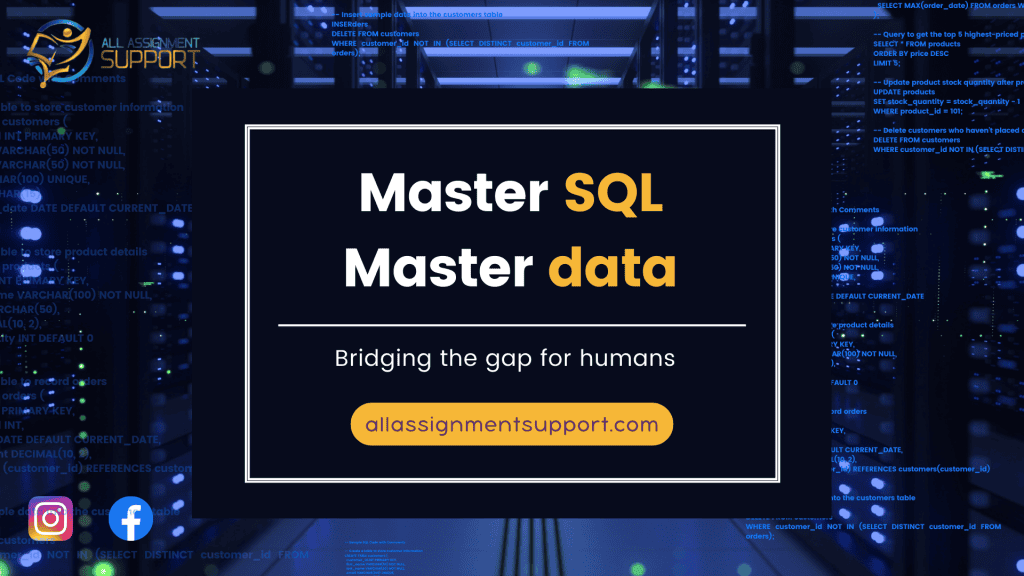Table of Contents
ToggleIntroduction
In the constantly developing software development sector, databases are the cornerstone for storing and managing massive amounts of data necessary for different applications and systems. Structured Query Language (SQL), which includes powerful facilities for data manipulation, has long been the standard language for interacting with databases. The “Sequel” programming languages, commonly called “SQL for Humans,” represent a new paradigm starting to take shape as user-friendly strategies become more necessary and developer expectations increase.
This article explores Sequel programming languages, unveiling their purpose as a user-centric and expressive alternative to traditional SQL. With a primary focus on simplifying database interactions, Sequel languages strive to provide developers of all levels with a more intuitive and readable experience, ultimately empowering them to unleash the full potential of databases.
Whether you are a seasoned developer trying to boost efficiency or a beginner eager to learn about database programming, this article will open your eyes to the paradigm-shifting possibilities of Sequel languages. By the end of our investigation, you’ll be equipped with the knowledge and resources required to embrace these cutting-edge solutions, optimize your database interactions, and begin your journey towards more logical and efficient data-driven development.
What are Sequel Programming Languages?
Sequel programming languages, sometimes known as “SQL for Humans,” represent a cutting-edge and original method of database programming. They want to make database interaction easier for developers and more intuitive and user-friendly. Although SQL has long been the preferred language for maintaining and accessing databases, Sequel languages provide a novel viewpoint that overcomes some drawbacks of conventional SQL.
● Purpose and Evolution
Sequel programming languages aim to give programmers a more expressive and legible syntax for working with databases. Their development is based on the premise that by making database queries and manipulations resemble everyday English; developers will find it simpler to comprehend and manage complicated database processes.
● Differences from Traditional SQL:
Sequel languages keep the fundamental ideas of SQL while frequently enhancing and simplifying the syntax. They concentrate on short, understandable instructions in an effort to lessen the need for boilerplate code. Contrary to SQL, which occasionally exhibits rigidity and verbosity, Sequel languages provide a more adaptable and elegant method.
Advantages of Sequel Languages
These are some of the attractive advantages you have when you learn or understand SQL languages. Helping you get a run-down through the same:
1. Readability
Sequel languages excel in readability, enabling developers to write and understand code more easily. Using intuitive commands and concise syntax reduces the learning curve, making it approachable for newcomers and enhancing team collaboration.
2. Maintainability
With a focus on clarity and simplicity, Sequel languages lead to more maintainable codebases. Developers can quickly identify and fix issues, reducing the risk of errors caused by complex SQL queries.
3. Developer Productivity
Sequel languages increase developer productivity by streamlining the database programming process. The natural language-like syntax allows developers to express their intentions more clearly, leading to faster development cycles and efficient code iterations.
4. Reduced Boilerplate Code
Sequel languages often abstract away boilerplate code, reducing the need for repetitive or verbose statements present in SQL.
5. Integration with Object-Oriented Programming
Certain Sequel languages seamlessly interact with object-oriented programming to bridge the gap between database structures and application models.
- Supported Databases: Sequel languages are made to operate with several database management systems, including NoSQL databases like MongoDB and relational databases like MySQL, PostgreSQL, and SQLite.
Sequel programming languages provide a new way of looking at database development by providing legible, expressive alternatives to conventional SQL. They deal with the difficulties of intricate database interfaces and give developers a more user-friendly and effective way to work with data.
Features of Sequel Programming Languages
Sequel programming languages have user-friendly features that has made programming way easier and intuitive. Let us move on to explore what these features are:
1. Intuitive Syntax
The intuitive syntax of Sequel languages, which aims to resemble natural language closely, is one of their key qualities. This enables programmers to create queries and handle data more understandably. Sequel languages replace difficult SQL statements with simple language phrases like “select,” “from,” “where,” and “order by,” making code more accessible and simpler to comprehend.
2. Method Chaining
A chaining method used by sequel languages frequently lets programmers combine several instructions or processes into a single line of code. This method of chaining strategy encourages a linear flow of reasoning by enabling brief and expressive queries while minimizing the requirement for unnecessary code indentation.
3. Expressive Operations
Sequel languages extend the range of operations that developers can perform on data. Beyond traditional SQL operations like filtering, sorting, and joining, Sequel languages may offer additional functionalities for common data manipulations, making complex tasks more accessible and less error-prone.
4. Abstraction of SQL Complexity
Sequel languages abstract away much of the complexity associated with SQL. This simplifies database interactions, shielding developers from dealing with low-level SQL intricacies and allowing them to focus on expressing their intentions more clearly and concisely.
5. ORM Integration
Object-Relational Mapping (ORM) frameworks are smoothly integrated with several Sequel languages. Bridging the gap between database structures and application models enables developers to operate with database records as though they were native objects in their programming language. With this integration, manual SQL-to-object mapping is not as necessary and code organization is improved.
6. Cross-Database Compatibility
Sequel languages are designed to be compatible with various relational and NoSQL databases to cater to a wide range of database management systems. This cross-database compatibility ensures developers can apply their knowledge and skills across different data storage solutions.
7. Readable Error Messages
Sequel languages focus on providing clear and meaningful error messages. This aids developers in quickly identifying and resolving issues in their code, leading to more efficient debugging and problem-solving.
By leveraging these in-built features that are present in Sequel languages, programmers have been able to empower programming abilities on a more superlative level. This way, data operations have been made generic and understandable to audiences who are not that tech savvy too.
Uses of Sequel Programming Languages
Because they simplify database interactions and provide a more natural way to work with data, sequel programming languages have grown in favor. Let’s examine some of the principal use cases where these languages shine and illustrate how successful they are in practical situations:
1. Data Retrieval
Sequel languages shine in data retrieval tasks, making it easy for developers to fetch specific records from databases. With their intuitive syntax and expressive commands, developers can construct queries to extract the exact data they need quickly and efficiently. Whether retrieving user information from a user table or fetching sales data within a specific date range, Sequel languages simplify the process and improve code readability.
2. Data Filtering and Manipulation
Various techniques are available for filtering and modifying data in sequel languages. Powerful clauses like “WHERE” and “HAVING” can be used by developers to provide criteria for data selection or aggregation. They can convert the data in more compact and organized ways by chaining many actions, including grouping, sorting, and aggregating.
3. Database Joins
In conventional SQL, performing joins may be difficult and error-prone when working with several tables in a database. Sequel languages, conversely, make this procedure easier by offering a simpler syntax for carrying out inner, outer, and cross joins across tables. This makes queries containing numerous data sources easier to interpret and lowers the possibility of joining mistakes.
4. Data Insertion and Updating
Data updates and insertion are made simple by sequel languages. The “INSERT” and “UPDATE” statements’ straightforward and succinct syntax allows developers to easily add new records to the database or edit already-existing ones.
5. Working with NoSQL Databases
Sequel languages are not limited to relational databases. They can be effectively used with NoSQL databases, such as MongoDB, to query and manipulate data in a more human-readable way. This flexibility allows developers to work with various databases without switching between different query languages.
6. ORMs and Application Integration
Sequel languages that integrate with ORMs bridge the gap between application code and database structures. This integration enhances code organization and allows developers to work with database records using familiar object-oriented programming principles. It simplifies database access and data management, especially in large-scale applications.
7. Report Generation and Analytics
Sequel languages are well-suited for generating reports and conducting data analytics. Their expressive nature allows developers to craft complex queries that extract, aggregate, and transform data into meaningful insights and reports.
Their user-friendly syntax and expressive operations enable developers to tackle complex database tasks with clarity and efficiency. Whether building interactive web applications, generating analytical reports, or managing large-scale databases, Sequel languages are invaluable tools that enhance database programming and streamline data operations in real-world scenarios.
Examples of Sequel Programming Languages
To gain a deeper understanding of the power and simplicity offered by Sequel programming languages, let’s explore concrete examples of popular languages in action. These examples will showcase how these languages streamline database interactions and make working with data a more intuitive and expressive experience.
Example 1: Sequel in Ruby (Sequel-Ruby):
# Connecting to a database
DB = Sequel.connect(“sqlite://my_database.db”)
# Creating a table
DB.create_table :users do
primary_key :id
String :name
Integer :age
end
See also What Does Engagement Mean On Facebook
# Inserting data into the table
users_dataset = DB[:users]
users_dataset.insert(name: ‘Alice’, age: 30)
users_dataset.insert(name: ‘Bob’, age: 25)
# Retrieving data from the table
alice = users_dataset.where(name: ‘Alice’).first
puts alice[:age] # Output: 30
# Updating data in the table
users_dataset.where(name: ‘Bob’).update(age: 26)
# Deleting data from the table
users_dataset.where(name: ‘Alice’).delete
In this example, we use Sequel-Ruby, which is a popular Sequel language for Ruby developers. We start by connecting to a SQLite database and then create a table named “users” with columns for “id,” “name,” and “age.” We insert two records into the table, retrieve data for “Alice,” update Bob’s age, and finally delete Alice’s record.
Example 2: Sequel in Python (Sequel-Python):
# Connecting to a database
import sequel
DB = sequel.connect(“sqlite:///my_database.db”)
# Defining a model
class User(sequel.Model):
name = sequel.CharField()
age = sequel.IntegerField()
# Creating a table
User.create_table()
# Inserting data into the table
alice = User(name=’Alice’, age=30)
alice.save()
bob = User(name=’Bob’, age=25)
bob.save()
# Retrieving data from the table
alice = User.get(name=’Alice’)
print(alice.age) # Output: 30
# Updating data in the table
bob.age = 26
bob.save()
# Deleting data from the table
alice.delete()
This example demonstrates Sequel-Python, a popular Sequel language for Python developers. We define a model “User” and create a table based on that model. We then insert two records into the table, retrieve data for “Alice,” update Bob’s age, and delete Alice’s record using intuitive object-oriented syntax.
Example 3: Sequel in JavaScript (Sequel-JS):
// Connecting to a database
const sequel = require(‘sequel-js’);
const DB = sequel.connect(‘mongodb://localhost/my_database’);
// Creating a collection
const users = DB.collection(‘users’);
// Inserting data into the collection
users.insertOne({ name: ‘Alice’, age: 30 });
users.insertOne({ name: ‘Bob’, age: 25 });
// Retrieving data from the collection
users.findOne({ name: ‘Alice’ }).then (alice => {
console.log(alice.age); // Output: 30});
// Updating data in the collection
users.updateOne({ name: ‘Bob’ }, { $set: { age: 26 } });
// Deleting data from the collection
users.deleteOne({ name: ‘Alice’ });
This example showcases Sequel-JS, a Sequel language for JavaScript developers. We connect to a MongoDB database, create a collection of “users,” and perform operations like inserting, retrieving, updating, and deleting data with straightforward syntax.
These concrete examples of popular Sequel programming languages demonstrate their effectiveness in simplifying database interactions. Sequel languages offer developers a seamless and user-friendly experience when working with data with their intuitive syntax, expressive commands, and object-oriented integration.
Sequel languages, from Ruby and Python to JavaScript, enable efficient and intuitive database programming across diverse development environments. By embracing these languages, developers can enhance productivity, maintainability, and clarity when building data-driven applications.
Comparing Sequel Languages with SQL and ORM
Developers have a variety of alternatives for dealing with databases, each of which has advantages and restrictions of its own. To determine their relative merits and when to use Sequel languages, let’s contrast classic SQL and Object-Relational Mapping (ORM) tools with Sequel programming languages.
1. Traditional SQL:
Pros:
- Maturity and Standardization: Because SQL has been around for a long time and is widely supported by various database management systems, database interactions will be standardized and user-friendly.
- Granular Control: With SQL, developers have fine-grained control over queries, making it suitable for complex data manipulations and optimizing performance in specific scenarios.
- Robustness: SQL is a proven and robust language for database operations, making it well-suited for handling large-scale and critical applications.
Cons:
- Verbose Syntax: SQL can be verbose, especially for complex queries, leading to decreased readability and increased development time.
- Higher Learning Curve: Beginners may find SQL’s complex syntax and declarative nature challenging to grasp initially.
- Boilerplate Code: SQL queries often require significant boilerplate code, making codebases more extensive and potentially error-prone.
2. Object-Relational Mapping (ORM) Tools:
Pros:
- Abstraction of Database Operations: ORM tools abstract away much of the complexity of database interactions, enabling developers to work with database records as objects in their programming language. This simplifies code and allows developers to think in terms of objects, improving maintainability.
- Database Independence: ORM tools provide a layer of abstraction that allows developers to switch between different database systems without rewriting queries, enhancing flexibility and scalability.
- Integration with Application Logic: ORM tools facilitate the integration of database operations with application logic, making it easier to build complex and feature-rich applications.
Cons:
- Performance Overhead: ORM tools may introduce performance overhead due to the additional layers of abstraction and mapping between objects and database records.
- Learning Curve and ORM-Specific Issues: Developers need to learn the specific ORM tool’s syntax and best practices, which can add to the learning curve. Additionally, dealing with ORM-specific issues and limitations can be challenging.
3. Sequel Programming Languages:
Pros:
- Readability and Expressiveness: Sequel languages excel in readability and expressiveness, resembling natural language commands. This enhances code comprehension, promotes collaboration, and reduces the likelihood of errors.
- Simplified Syntax: Sequel languages abstract away much of the complexity present in traditional SQL, resulting in shorter and more concise queries.
- Easy Integration: Sequel languages are often designed to work seamlessly with popular programming languages and databases, facilitating easy integration into existing projects.
Cons:
- Limited to Database Operations: Unlike ORM tools, Sequel languages are primarily focused on database interactions and may not offer the same level of object-oriented abstraction for other application logic.
- Complex Queries: While Sequel languages simplify most queries, very complex operations may still require some familiarity with SQL or specific database knowledge.
When do you Choose Sequel Languages?
When do you choose to use sequel languages? Here are pointers pertaining to the same:
1. Readability and Maintainability
When code readability and maintainability are critical, Sequel languages shine, making them ideal for projects with a strong emphasis on clean and intuitive code.
2. Productivity and Rapid Development
Sequel languages reduce boilerplate code and simplify data operations, accelerating development cycles and boosting developer productivity.
3. Integration with Existing Projects
Developers already working with a specific programming language may find Sequel languages that integrate seamlessly with their technology stack appealing.
Sequel programming languages offer a refreshing and intuitive alternative to traditional SQL and ORM tools.
Getting Started with a Sequel Language
If you are intrigued by the simplicity and power of Sequel programming languages and want to start exploring this innovative approach to database programming, this section has valuable resources, tutorials, and tips to help you get started.
1. Choosing the Right Sequel Language
Before diving in, consider the programming language and database management system you are most comfortable with. Sequel languages have various implementations for different languages and databases. Popular options include Sequel-Ruby, Sequel-Python, and Sequel-JS for Ruby, Python, and JavaScript developers.
2. Official Documentation
For each Sequel language, explore its official documentation. These resources offer comprehensive guidance, covering installation instructions, language syntax, and examples of common database operations. The official documentation is the primary source of accurate and up-to-date information about the language.
3. Online Tutorials and Guides
Numerous online tutorials and guides cater to developers getting started with Sequel languages. These resources often provide step-by-step instructions, practical examples, and real-world use cases to help you grasp the language concepts quickly. Look for tutorials that align with your preferred programming language and database system.
4. Community Forums and Support
Engaging with the community can be invaluable when learning a new language. Participate in online forums, discussion boards, and social media groups dedicated to Sequel languages. You can ask questions, seek help with specific challenges, and learn from experienced users’ insights.
5. Code Examples and Repositories
Explore open-source projects and code repositories that utilize Sequel languages. Analyzing real-world code examples can deepen your understanding of best practices and how to apply Sequel languages in practical scenarios.
6. Libraries and Frameworks
Many programming languages have libraries or frameworks that integrate seamlessly with Sequel languages, enhancing their capabilities and providing additional functionalities. Research and choose libraries that align with your project requirements for a smoother integration process.
7. Practice and Hands-On Experience
The best way to learn a new language is through hands-on experience. Create small projects or exercises to practice using Sequel languages. Implement various database operations, experiment with different data structures, and observe how the language simplifies database interactions.
8. Online Courses and Video Tutorials
Consider enrolling in online courses or watching video tutorials that focus on teaching Sequel languages. These resources often offer structured learning paths, interactive exercises, and instructor-led guidance to accelerate your learning journey.
9. Learning by Doing
Building a Sample Project: To solidify your understanding, work on a sample project that involves database interactions. Building a small web application or data-driven project allows you to apply Sequel languages practically and reinforces your learning through hands-on development.
10. Read and Analyze the Source Code of Sequel Libraries
To understand how Sequel languages are implemented, explore the source code of popular Sequel libraries. This can give you insights into language design choices and implementation details.
Concluding Lines
Sequel programming languages are a valuable addition to the developer’s toolkit, bridging the clarity of natural language and the power of database interactions. By embracing these languages, developers can streamline database interactions, simplify data operations, and build robust, efficient, and maintainable applications.
Whether you are a seasoned developer seeking productivity enhancements or a newcomer eager to explore modern database programming, Sequel languages offer an exciting and user-friendly path to harnessing the full potential of databases in the dynamic world of software development. Embrace the journey of learning and mastering Sequel languages, and empower yourself to become a more proficient and effective data-driven developer.
Frequently Asked Questions
1. Name some of the popularly known SQL databases that are widely in use even today
Answer: Oracle, Microsoft, Sybase, Ingress and Access are popularly known databases that support SQL programming and are widely used today. User-friendly CRMs have also been developed using the programming efficacies of SQL databases.
2. If I have a programming assignment using SQL databases, do I avail help online?
Answer: Yes, we have experts who cover intensive assignments that use SQL databases through All Assignment Support. Our expert tutors will also help you gauge the different components of SQL, like Data Manipulation Language (DML), Data Definition Language (DDL), Data Control Language (DCL), and so on.
We have a pool of talented Ph.D. professionals who specialize in using SQL-enriched databases to help you finish any project like a pro. Login to SQL Assignment Help to understand how we help our students on a more intensive level.
3. What are some of the advantages of SQL programming?
These are some of the enhanced benefits with respect to SQL programming:
- You find that SQL programming is open-sourced.
- SQL programming supports high-performance languages in an engaging manner.
- SQL supports robust transactions and complex operations seamlessly.
- You can enjoy a high degree of flexibility and scalability using SQL programming.
- The programming done with SQL languages supports high security for your websites.
- SQL databases have high demand in the marketplace.
- SQL databases ease out management operations in a seamless manner
- SQL supports comprehensive application development of websites, CRM and user-driven applications hassle-free.
4. How can programming assignment help services combine SQL and other programming languages for my semester projects?
Answer: Quite a lot of latest programming languages that does coding using Java, Python, .NET, etc make use SQL databases at their back end to add a degree of accuracy and precision to the project excellence you are aiming for.
Therefore, if you want to avail services for getting your programming assignments done seamlessly, you must have thoroughly knowledgeable professionals who combine coding with languages using SQL databases.
At the All Assignment Support, we have PhD professionals who have extensive knowledge on independent segments of data programming that gets camouflaged with using SQL.
Therefore, for your University mid-semester or internal project evaluations, getting a service oriented help can go a long way in accelerating your grades for your internals.
5. Does having a strong knowledge of SQL programming help me with career?
Answer: Well, the answer is a simple yes. SQL programming is extensively used by data scientists, data administrators and back-end research analysts to derive reports and statistical data in a precise and unbiased manner.
Quite a lot of raw data figures or random numbers are fed into computational devices to get meaningful data sets and validated info. By using the program-related coding for front-end operations that is supported by SQL data programming, you get amplified results in a shorter span of time.
Therefore, when you have a strong knowledge of SQL programming, it helps you thrive in the software and data analytics industries that provide prime opportunities to young graduates across the globe.
6. Explain the compatibility between 3-tier internet architecture and SQL architecture
Answer: The connection between a three-tier internet architecture and that of SQL programming can be established in ways more than one. Three tier internet architecture comprises of three exclusive layers. These are:
- A presentation layer
- An application layer and
- A data layer
That being said, let us learn what SQL architecture comprises of. SQL refers to a data management system that tells the end-users on how to feed data into computer systems and retrieve them in a well-compiled manner and this is done using standardized techniques.
Therefore, when a 3-layered internet architecture combines with SQL, then you can handle user-interaction, business logic and data storage in an effective manner indeed.
7. How does SQL support multiple data views?
Answer: When you use SQL data base management systems to support your programming languages, you get a multi-dimensional perspective on getting your job done. This is mainly because, SQL data bases allow end-users to store or retrieve data in the manner that is appealing or compatible to their line of businesses.
Therefore, you can look for customized ways of using programming languages that can be tailor-made to suit your independent needs and requirements.
Say for instance, you have already compiled a coding for retrieving data from specific subsets or columns. Using an SQL aided DBMS, the end-user just has to type a query stating which data’s row or column related info has to be retrieved from the lengthy table comprising of hundreds of rows or columns.
And then, through the ease of managing data with SQL, you only get that specific row-column’s data subset. That is how convenient it is when you combine your main programming language with SQL data systems. Pay Roll processing makes use of SQL DBMS extensively indeed.
8. How does SQL programming help me with a faster query processing?
Answer: SQL data management systems are tailor made to retrieve sets of data in a faster manner. This is mainly because SQL data base management systems are capable of handling huge volumes of data that is used for computing several complex transactional queries in a speedier manner.
SQL DBMS also works on the concept of indexing. This means, the moment you compile data sets into computational systems, the data sets are indexed according to their compatible prototypes. Therefore, the computers find it easier to retrieve or access information seamlessly.
To add the brownie points, SQL programming works on set-based operations. This means, you can add data sets in two’s or three’s. Therefore, manipulation of data or retrieval of data sets becomes easier when the system takes two to three data subsets as against processing a query using a singular row or column it is situated in.
In a nutshell, you get a superlative degree of efficiency due to above mentioned features, SQL data base management systems have, over your regular programming mode.
9. What kind of coding skills do I require to master SQL programming?
Answer: SQL programming is simpler to crack as against learning complex programming languages like Java, C++ or .NET. Here, the syntax rules are simpler to learn or master as SQL makes use of user-friendly keywords. These are words like ‘SELECT,’ ‘INSERT INTO’ or even ‘UPDATE’
This way, non programming executives can grasp or master SQL programming even if they do not have a prior experience of coding. Therefore, beginners or amateurs who have a limited knowledge of computers can also learn SQL programming and master the nuances connected with the same within a shorter span of time.
10. What is SQL programming?
Answer: SQL is also known as SEQUEL. This is an acronym that stands for Structured English Query English. Therefore, the key words comprise of basic English words that even a layman can easily understand.
Again, you must also understand the fact that SQL has the ability to interact with other databases too, in a seamless manner. Therefore, SQL is the fundamental language of programming you may have to learn in order to scale up your level of operations with relational data bases too.











